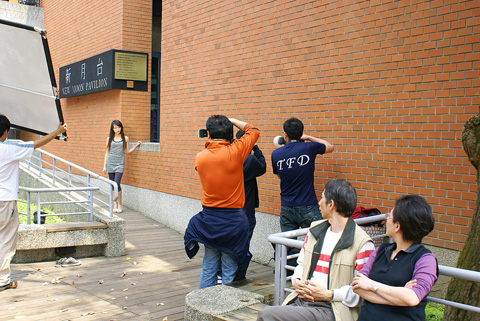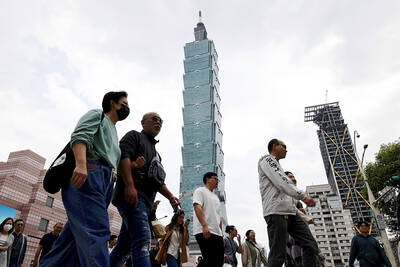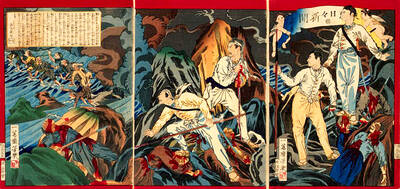Firevo (打火) crouches and points the telephoto lens between the legs of the young woman sitting on the ground a meter in front of him. She wears a sleeveless pink top, white high heels, short shorts and black stockings that reach just beyond the knees — the kind of night-market chic popularized by starlets like Jolin Tsai (蔡依林).
At first oblivious to the Firevo’s clickings, she soon turns and faces him, her expression changing as the aperture clicks in a flurry of snaps. A paparazzo busted after taking a few secret photos?
Quite the contrary. Firevo has paid to participate in a highly structured activity that has exploded in popularity over the past few years. As the amateur photographer lifts himself off the ground, other amateur photographers — nine in all — move in on their muse.

PHOTO: NOAH BUCHAN, TAIPEI TIMES
“I do this almost every weekend. It’s kind of my hobby,” says the 26-year-old, who has the diffident manner of a person uncomfortable speaking with strangers. Put him behind the lens of his Canon EOS D5, however, and Firevo loses all timidity.
The nine photographers signed up online with i-photo (also called lovephoto) an agency that organizes waipai (“outside photography,” 外拍) in scenic areas for three-hour photo shoots of amateur models.
A proliferation of “photo album” blogs coupled with traditional Taiwanese ideas of beauty make waipai a popular hobby for many men. Young women enthusiastically sign up with the Web sites to earn extra cash and, possibly, turn an amateur weekend gig into a professional modeling career.

PHOTO: NOAH BUCHAN, TAIPEI TIMES
Tim Lai (賴政廷), co-founder of i-photo, says his Web site has signed up more than 8,000 photographers and more than 200 models in the past five years. The site stages 50 such events per month in seven cities throughout Taiwan.
Lai estimates there are at least 30 waipai Web sites in Taiwan, with 10 being as large or larger than i-photo. Though there are no figures that show how many waipai blogs or online photo albums exist, according to Lai, anecdotal evidence suggests the number runs in the tens of thousands.
Lai posts images of models on the i-photo Web site (www.i-photo.com.tw) every Monday night. Signing up for a waipai photo shoot is easy. Clicking on a model’s image brings would-be photographers to a page with details such as the model’s personal characteristics, body measurements and blood type. Those interested register online by leaving their phone number and a nickname, then show up on the appointed day at the scenic area, pay between NT$700 and NT$1,200, and begin a three-hour photo shoot.
Like Firevo, Bany Hsiao (蕭長城) sees waipai as a hobby. The “40-something” salesman for a semiconductor company says the camaraderie keeps him coming back to waipai.
“It’s just for fun, a leisure activity … [with] people who share the same interests. Most [of us] have taken pictures together before and it creates a good atmosphere,” Hsiao said, as he and seven other photographers wandered around behind a model.
The camaraderie among the photographers is evident. They joke with each other during the photo shoots and often have lunch or coffee together afterwards.
A mutual interest in the gadgets — many of them top-of-the-line — ensures an ongoing banter. Lai said it is natural for photographers to buy semi-professional and professional digital SLR cameras because, since many of the photographers are engineers or work in the computer industry, they are familiar with the latest technology.
Sometimes, however, a photographer will show up with low-end hardware.
“I remember one guy who came out with a compact camera,” Lai said. “The next time he showed up with a top-of-the-line Nikon.”
Chen says if it weren’t for blogs, waipai wouldn’t be as popular as it is.
“There has to be a place to display the images. Otherwise, for the photographers, taking these pictures would have no meaning,” he said.
Joseph R. Allen, a professor in and chair of the Department of Asian Languages and Literatures at the University of Minnesota, says the waipai phenomenon is related to the “pretty woman” (美人) genre of photography that has been popular in Taiwan for decades.
“I remember seeing many examples of this in the 1970s [and] 1980s, with a group of photographers, invariably male and older, with a ‘model’ posing in various locations. Sometimes these took on the edge of soft-core porn. So what you are seeing seems to be part of a longer tradition,” he wrote in an email.
“The popular perception of these guys is that they are zhainan,” said Chang Sheng-ta (章聖達), who manages an online photography company called Digital Baby (數碼寶貝數位影像). The term zhainan (宅男) refers to anyone exhibiting nerdy behavior and evokes comparisons to the Japanese otaku phenomenon.
Zhang says that a lack of female contact at work makes many Taiwanese men shy around women. With long working hours in an industry that employs few women, it is hardly surprising that most waipai photographers work for computer or information technology companies.
“These guys are shy and have difficulty talking to women,” said Benson Chen (陳宗暉), an embedded systems engineer who operates a digital camera board on National Taiwan University’s bulletin board system (BBS). “This kind of activity provides an ideal setting for them to interact with many different women.”
“It’s like a peep show, except it’s legal and public,” Chen said. “The camera is like a curtain they can stand behind and use to look at beautiful women without fear or consequence.”
The greatest concern models have is safety, and agencies gain a positive or negative reputation based upon how well they protect the young women.
Local media have reported a slew of cases where modeling agency photographers lure impressionable young women to hotels or remote spots under the pretext of boosting their modeling careers, only for the women to learn that other motives are at play.
In one case, two photographers surnamed Lin (林) and Chou (周) were charged with forced sexual intercourse (強制性交) after they lured a young woman to a motel and coerced her to strip for a number of photographers, according to a report in the Liberty Times (the Taipei Times’ sister newspaper).
The newspaper reported that each photographer paid between NT$3,000 and NT$8,000 for the opportunity to photograph the model. Afterwards, the “chaperones” threw a few thousand NT dollars on the bed before leaving.
Other model agencies have been accused of using waipai as a pretext to sell sex.
“Some of [the models] are a kind of product introduction,” joked Hsiao, referring to the more lurid waipai activities.
Although waipai, like other zhainan-oriented hobbies, has gained a derogatory reputation with Taiwan’s gossip-obsessed media, the four amateur models interviewed for this story said they felt safe around the photographers. (The women’s names have not been published to protect their privacy.)
This is probably because most waipai photo shoots rarely allow for direct model-photographer interaction. For example, i-photo has developed a good reputation because it enforces a clear separation between photographer and model.
“Where the models stand, their pose … it’s mostly decided by us, not the photographers,” said Alex Chou (周以立), a photography instructor and volunteer chaperone with i-photo. “And they rarely talk to the model,” he said.
Volunteer chaperones instead of photographers positioning the models is the only exception to an activity that otherwise imitates the fashion industry — where Taiwan’s scenic areas replace the runway, an amateur model pretends to be the real thing, and photographers pose as professionals. With waipai, the photographer becomes both creator and consumer of the images they are manufacturing.
But for Firevo and the eight other photographers, it’s simply a way to get out and meet people and take a few pictures of beautiful women.
“I couldn’t see myself doing anything else on the weekend,” he said.
Next week: Amateur models talk about waipai photo shoots

In the March 9 edition of the Taipei Times a piece by Ninon Godefroy ran with the headine “The quiet, gentle rhythm of Taiwan.” It started with the line “Taiwan is a small, humble place. There is no Eiffel Tower, no pyramids — no singular attraction that draws the world’s attention.” I laughed out loud at that. This was out of no disrespect for the author or the piece, which made some interesting analogies and good points about how both Din Tai Fung’s and Taiwan Semiconductor Manufacturing Co’s (TSMC, 台積電) meticulous attention to detail and quality are not quite up to

April 21 to April 27 Hsieh Er’s (謝娥) political fortunes were rising fast after she got out of jail and joined the Chinese Nationalist Party (KMT) in December 1945. Not only did she hold key positions in various committees, she was elected the only woman on the Taipei City Council and headed to Nanjing in 1946 as the sole Taiwanese female representative to the National Constituent Assembly. With the support of first lady Soong May-ling (宋美齡), she started the Taipei Women’s Association and Taiwan Provincial Women’s Association, where she

Chinese Nationalist Party (KMT) Chairman Eric Chu (朱立倫) hatched a bold plan to charge forward and seize the initiative when he held a protest in front of the Taipei City Prosecutors’ Office. Though risky, because illegal, its success would help tackle at least six problems facing both himself and the KMT. What he did not see coming was Taipei Mayor Chiang Wan-an (將萬安) tripping him up out of the gate. In spite of Chu being the most consequential and successful KMT chairman since the early 2010s — arguably saving the party from financial ruin and restoring its electoral viability —

It is one of the more remarkable facts of Taiwan history that it was never occupied or claimed by any of the numerous kingdoms of southern China — Han or otherwise — that lay just across the water from it. None of their brilliant ministers ever discovered that Taiwan was a “core interest” of the state whose annexation was “inevitable.” As Paul Kua notes in an excellent monograph laying out how the Portuguese gave Taiwan the name “Formosa,” the first Europeans to express an interest in occupying Taiwan were the Spanish. Tonio Andrade in his seminal work, How Taiwan Became Chinese,